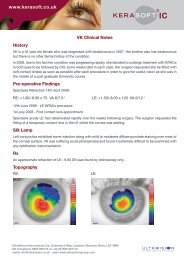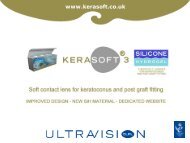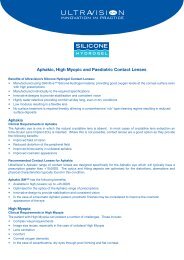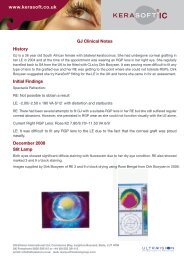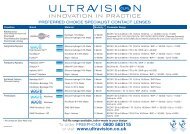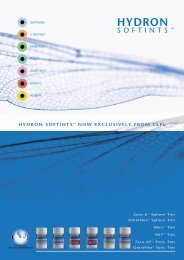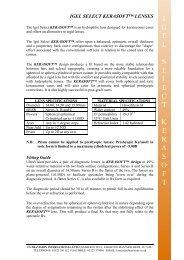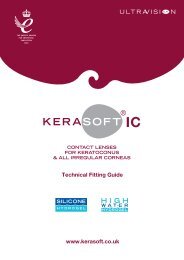KeraSoft 3 Extended Fitting Guide - UltraVision Group
KeraSoft 3 Extended Fitting Guide - UltraVision Group
KeraSoft 3 Extended Fitting Guide - UltraVision Group
Create successful ePaper yourself
Turn your PDF publications into a flip-book with our unique Google optimized e-Paper software.
Lens Movement/Laser Mark<br />
The <strong>KeraSoft</strong> ® 3 has more substance than most lathe-cut soft contact lenses and therefore can demonstrate much more<br />
movement than a typical soft lens. One way of assessing the movement is to assess the rotational behaviour of the lens, utlising<br />
the laser mark.<br />
Figure 4<br />
Each trial lens has a laser mark that indicates the position of the prism<br />
ballasting (see Figure 4). This mark should usually be inferior and vertical,<br />
and should remain vertical even if the lens moves 2-3mm post-blink. If<br />
the mark rotates back and forth unpredictably with blinking, this is usually<br />
an indication that the lens is too flat. Sometimes the laser mark will simply<br />
orientate slightly off axis. However, this is acceptable as long as the lens<br />
stays rotated in that position.<br />
This picture also shows how much a <strong>KeraSoft</strong> ® 3 lens can drop on upward<br />
gaze and still be a good fit.<br />
Important: The position of the laser mark should always be given when<br />
ordering the final lens.<br />
Over Refraction<br />
Accurate refraction is always a problem with keratoconics, so it may be difficult to establish a good starting point for over<br />
refraction. When using RGPs, it is typical to think in terms of the spherical over refraction. However, with <strong>KeraSoft</strong> ® 3 it is<br />
important to assess the astigmatic over refraction as well as the sphere. One good way to get a starting point is to use the<br />
autorefractor over the top of the lens. This is usually more accurate using the IOL setting on the autorefractor (if it has this<br />
setting). This method will usually give a good indication of any astigmatism present.<br />
An extra source of information is that provided by the use of topography over the top of the lens. Although no indication of<br />
sphere is given, usually there is a good idea of cyl and axis which, combined with the autorefractor results, can be very helpful.<br />
It is always worth looking at the cyl correction, even if the patient can achieve quite good results with a sphere alone. This is<br />
due to the fact that keratoconics, especially those who have not yet been fitted with contact lenses, tend to tolerate<br />
shadowing and doubling of images very well, so double check to see if giving the cyl will help acuity.<br />
If the over refraction gives disappointing or unexpected results, the fit needs to be reassessed. If there is little lens movement<br />
and the vision fluctuates on blinking, then it is recommended that a flatter lens is tried. Sometimes, if vision is not as expected<br />
and all lenses appear quite tight, this can indicate that a 14.00mm diameter lens is required.<br />
Vision that varies unpredictably can mean the lens is too flat, in which case the rotation should be double checked using the<br />
laser mark as a guide.<br />
Once the suitable fit and vision are achieved, the initial fitting lens (with warranty included) can be ordered. For this the<br />
following information is required:<br />
Trial lens details: BCOR, Diameter and power<br />
Laser mark position<br />
Over refraction<br />
HVID<br />
BVD<br />
Note: If the over refraction axis has automatically been corrected to take into account the position of the laser mark, this<br />
should be made clear when placing the order for the lens.<br />
Checking the ordered fitting lens<br />
When the lenses are received, check for fit and vision. If the vision/fit is not as expected, then over refract with the lens in situ,<br />
as sometimes adding the cylinder changes the dynamics of the lens slightly and the lens sits in a different position.<br />
Over refraction may give a significant cyl at a different axis. This is an induced effect of the cyl sitting at the wrong axis and<br />
the correction needed can be calculated from the results achieved. The lens can be re-ordered giving the over refraction<br />
results and/or the new rotated position using the laser mark. Again, over refraction using autorefractor is useful in this<br />
situation.<br />
ULTRAVISION INTERNATIONAL LIMITED, COMMERCE WAY, LEIGHTON BUZZARD, BEDFORDSHIRE, LU7 4RW, UNITED KINGDOM<br />
Tel: +44 (0)1525 381112 Fax: +44 (0)1525 370091 UK Order Line: 0800 585115 (Freephone)<br />
Email: orders@ultravision.co.uk Web: www.ultravision.co.uk; www.kerasoft.co.uk; www.siliconehydrogel.co.uk



